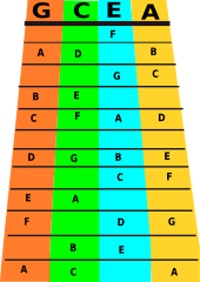Best Ukulele for
Beginners
-
Overall: 9.5/10
-
Best Feature: satin-smooth finish and play with ease
-
TedScore™: 9.5/10
Best
Professional
Ukulele
-
Overall: 9/10
-
Best Feature: unmatched playing experience
-
TedScore™: 9/10
Best Versatile
Ukulele
-
Overall: 9.5/10
-
Best Feature: impressive sound
-
TedScore™: 9.5/10
What is Ukulele Standard Tuning?
A ukulele gets its lovely sound from a special way of tuning the strings, known as standard tuning.
The standard tuning for a ukulele is GCEA, which means the strings are tuned to the notes G, C, E, and A, respectively.
The G string is typically tuned to a higher pitch than the other three strings, which are tuned to lower pitches.

Why is Ukulele Standard Tuning Important?
Ukulele standard tuning is important because it allows you to play along with other musicians who are also using standard tuning.
It also helps you to develop your ear for pitch and to recognize when your ukulele is out of tune.
Plus, using standard tuning can make it easier to learn new songs and play along with recordings.
How is Ukulele Standard Tuning Achieved?
To achieve standard ukulele tuning, you must use a tuner or another reference pitch to tune each string to the correct note.
You can use online ukulele tuner, a clip-on tuner, a chromatic tuner, a smartphone app, or another instrument, such as a piano or guitar to help you tune your ukulele.

When tuning your ukulele, it’s important to tune each string in the correct order, starting with the G string and working your way down to the A string.
You should also tune each string to the correct pitch, as indicated by your tuner or reference pitch.
Types of Ukulele Standard Tuning
High G Tuning
Low G Tuning
ADF#B Tuning
D-Tuning
Tips for Tuning
A clip-on tuner is a small device that attaches to the headstock of your ukulele and detects the pitch of each string.
It’s an easy and accurate way to ensure your ukulele is in tune. Simply pluck each string and adjust the tuning pegs until the tuner indicates the correct pitch.
Tuning your ukulele too tightly can cause the strings to break while tuning it too loosely can result in a dull sound.
It’s important to find the right balance of tension for each string. As you tune, listen carefully to the sound of each string and adjust the tension accordingly.
If you’re using an electronic tuner that relies on a microphone to detect the pitch of your ukulele, try experimenting with different microphone placements.
Placing the microphone too close to the sound hole can result in an inaccurate reading while placing it too far away can result in a weak signal. Try moving the microphone around until you find the sweet spot.
Tuning your ukulele can be frustrating, especially if you struggle to get it right. Don’t be afraid to ask for help from a more experienced player or a music teacher.
They can offer valuable advice and guidance to help you get the best sound out of your instrument.
Ukulele Sizes and Tunings
If you are new to playing the ukulele, you may not be aware that there are different sizes of ukuleles available.
The four most common sizes are soprano, concert, tenor, and baritone. Each size has its own unique sound and tuning.
Soprano Ukulele Tuning
Concert Ukulele Tuning
Tenor Ukulele Tuning
Baritone Ukulele Tuning
5 Recommended Ukeleles for Beginners
Kala Satin Mahogany KA-15S Soprano Ukulele

FEATURES:
-The all-mahogany build produces
a wealth of sweet, melodic tones
- Revel in the vibrant, cozy, and reactive
personality of this ukulele
- Glide your fingers effortlessly on the satin-smooth
finish and play with ease
OTHER INFO: Text
- With high-quality Aquila Nylgut strings for dependable warmth and tuning stability
- Budget-friendly yet offers a diverse range of tonal qualities
- None!
When you click ‘Check Price’, you’ll see there are loads of great places to buy this item. Our personal favorite is Sweetwater for the US, and Thomann and Gear4Music for the UK & Europe.
They are the largest music retailers, with excellent customer service, competitive prices, really fast shipping, and the longest guarantees.
The professional musician who wrote this article combined many things,
from the product build, manufacturer’s reputation through to feedback
from other users, to create our famous TedScore™.
Martin C1K Ukulele

FEATURES:
-The stunning koa
build produces a harmonious, well-rounded, and transparent sound
- The cozy shape and velvety-smooth finish provide an
unmatched playing experience
- Has a lightweight design that makes playing a breeze
- The concert shape provides a mesmerizing, full-bodied sound with unparalleled range and dimension
- Comes with a cushioned gig bag to safeguard your uke from any bumps and bruises
- Slightly pricier than some other ukuleles in its category
When you click ‘Check Price’, you’ll see there are loads of great places to buy this item. Our personal favorite is Sweetwater for the US, and Thomann and Gear4Music for the UK & Europe.
They are the largest music retailers, with excellent customer service, competitive prices, really fast shipping, and the longest guarantees.
The professional musician who wrote this article combined many things,
from the product build, manufacturer’s reputation through to feedback
from other users, to create our famous TedScore™.
Luna Tattoo Concert Mahogany Ukulele

FEATURES:
- Made with a distinctive design
inspired by the customary Hawaiian body adornment
- The mahogany construction provides a cosy and
harmonious tone
- Produces a warm and sonorous sound ideal
for playing a range of styles
- Comfortable concert size, which offers an extended playing range
- Comes with a convenient Luna travel bag, perfect for taking on your musical journeys
- The ukelele's design may not be appealing to everyone
When you click ‘Check Price’, you’ll see there are loads of great places to buy this item. Our personal favorite is Sweetwater for the US, and Thomann and Gear4Music for the UK & Europe.
They are the largest music retailers, with excellent customer service, competitive prices, really fast shipping, and the longest guarantees.
The professional musician who wrote this article combined many things,
from the product build, manufacturer’s reputation through to feedback
from other users, to create our famous TedScore™.
Cordoba 20CM Concert Ukulele

FEATURES:
- The solid mahogany construction
creates an impressive sound from such a diminutive instrument
- With rosewood bridge and fingerboard to add a layer of warmth to the sound
- A handmade design that provides a classic appearance
- The traditional concert shape is perfect for young learners and adults alike
- May not be the best option for those with limited funds
When you click ‘Check Price’, you’ll see there are loads of great places to buy this item. Our personal favorite is Sweetwater for the US, and Thomann and Gear4Music for the UK & Europe.
They are the largest music retailers, with excellent customer service, competitive prices, really fast shipping, and the longest guarantees.
The professional musician who wrote this article combined many things,
from the product build, manufacturer’s reputation through to feedback
from other users, to create our famous TedScore™.
Luna Honu Turtle Soprano Ukulele

FEATURES:
-The "C"-shaped neck provides a velvety-smooth and
comfortable feel with an irresistible character
- Offers a cozy playing experience for all levels of
players with its iconic soprano body
- The all-mahogany build exudes a warm, inviting tone
with a genuine ukulele jingle
- Advantages include a striking Hawaiian appearance with a genuine turtle pattern
- Comes with a handy gig bag for easy portability
- May be a bit smaller than some other ukuleles.
When you click ‘Check Price’, you’ll see there are loads of great places to buy this item. Our personal favorite is Sweetwater for the US, and Thomann and Gear4Music for the UK & Europe.
They are the largest music retailers, with excellent customer service, competitive prices, really fast shipping, and the longest guarantees.
The professional musician who wrote this article combined many things,
from the product build, manufacturer’s reputation through to feedback
from other users, to create our famous TedScore™.
Ukulele Standard Tuning
A Recap
Hey, congrats! You’re now a pro at tuning your ukulele to the most common tunings. Tuning is an important skill for any player, so you’re off to a great start.
Quick recap: GCEA is the standard ukulele tuning, and re-entrant tuning means the fourth string is higher than the third string.
To calibrate your ukulele tunings, use a clip-on ukulele tuner and adjust the tuning pegs until each string matches the right pitch.
Keeping your uke in tune is key to getting the best sound possible. And don’t forget to practice – tuning may take some time, but you’ll get the hang of it!
Now it’s time to start strumming and let your creativity shine. Happy playing!
Wait, there’s more!!!
Are you looking for a high-quality ukulele? Look no further than these top brands, known for their exceptional craftsmanship, beautiful sound, and wide range of styles to suit any player’s needs.
FAQ's
The four strings on an A ukulele are tuned to the notes A, E, C#, and F#. They are typically tuned in a high G tuning, where the G string is tuned an octave higher than usual.
The ukulele is tuned to GCEA because it provides a bright and cheerful strings sound, which us a characteristic of the instrument. This tuning also allows for easy chord shapes and makes it easy for beginners to learn and play songs.
Yes, standard ukulele tuning is often called high G tuning because the G string is tuned to a higher octave than expected. This tuning is popular among ukulele players because it provides a bright and happy sound well-suited to the instrument.











Not to stir the pot, but isn’t ADF#B tuning more historically accurate for traditional ukulele songs from Hawaii? I find it fascinating how tuning methods can change the entire feel of a song, and sometimes, modern interpretations lean too heavily on standard tunings, overlooking the unique sounds that come with traditional tunings like ADF#B.
D-tuning sounds cool gonna try it thanks for the tips
Lewis
Important point to mention, Lewis, about the low G tuning–it does indeed offer a wider range and a somewhat deeper sound that’s more aligned with guitars. This can be especially beneficial for those attempting to blend ukulele sounds into more traditional band setups where that extra depth can compensate for bass frequencies.
Hey Lewis , fantastic overview on ukulele tuning! I’ve been juggling with my guitar and a newly gifted ukulele, and the transition’s been quirky but fun. With the
Would you guys suggest sticking with the high G tuning for a total beginner? kinda worried about learning curves.
Hey MelodyScribe, I’ve been through the same phase transitioning from guitar to ukulele. Stick with it, and you’ll find the ukulele’s high G tuning incredibly unique and fun. It gives the uke that unmistakable bright sound.